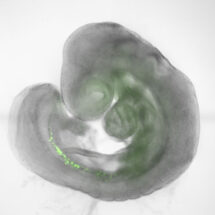
Germ cells face a significant threat to their genetic integrity during embryonic development. Ross Hill and Gerry Crossan, of the Crossan Group in the LMB’s PNAC Division, have recently found that these cells need a specific form of DNA repair, known as crosslink repair, in order to develop normally. The findings have been published online in Nature Genetics on July 31, 2019.
Germ cells (sperm and eggs) constitute the pipeline that passes on the genetic instructions to make a new organism. It is therefore essential that this genetic information remains free from errors, also known as mutations. Mutations in the DNA of sperm and eggs can result in severe consequences for the offspring, leading to developmental abnormalities and are ultimately responsible for causing inherited diseases.
In order to interrogate the role of DNA crosslink repair in germ cells, Ross and Gerry generated mouse models with defective DNA crosslink repair that allowed them to study the importance of repairing DNA damage during the development of new sperm and eggs. Crosslink repair is the process by which a type of DNA damage that glues the two strands of the DNA helix together is repaired. By comparing the embryonic development of mice with faulty DNA crosslink repair to those with active crosslink repair, Ross and Gerry showed that when this repair system is absent, germ cells accumulate DNA damage at a very early point in embryonic development.
Germ cells that accumulate damaged DNA activate a process known as apoptosis or programmed cell death. This observation supports the idea that germ cells with corrupted genetic information may be prevented from passing on damaged genetic information by undergoing cell suicide. This suggests that there are quality control mechanisms that restrict damaged DNA from being passed on to our children, but rendering the parent infertile.
This study also has implications for our understanding of infertility, as Ross and Gerry show that infertility may arise due to defects during our own embryonic development (when we were in the womb). They also provide an explanation for why human patients with Fanconi anaemia (a rare genetic blood disorder that prevents bone marrow from making enough new blood cells), who have faulty DNA crosslink repair, are infertile.
These findings are significant as they show that the process of germ cell development during embryonic life poses a threat to the fidelity of DNA, and the ability to produce sperm and eggs that are mutation-free. However, what causes the initial DNA damage in developing cells is still unclear. This research is a part of the Gerry Crossan Lab at the LMB, which focuses on how germ cells maintain genomic stability, as the maintenance of genetic integrity in the germline is of critical importance to ensure the faithful transmission of the genome from one generation to the next.
This work was funded by the MRC.
Further references:
DNA crosslink repair safeguards genomic stability during pre-meiotic germ cell development. Hill, JH., Crossan, GP. Nature Genetics 51(1283–1294)
Gerry’s group page